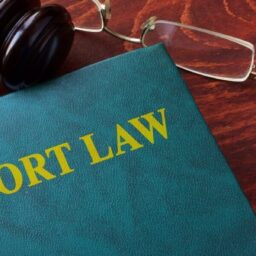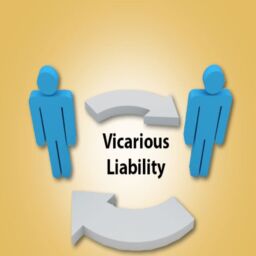
INTRODUCTION
Liability arises when a person is legally responsible for something. Usually, a person is responsible for the acts committed by him, however, in certain circumstances; a person can be made liable for the act committed by others. It is the general rule of vicarious liability. The Doctrine of Vicarious Liability applies when there is some relationship between the parties and the act committed is within the course of employment. The relations in whom vicarious liability of a person arises could be of master and servant, principal and agent, partners or owner and independent contractor.
The rule of vicarious liability is rooted in the Latin maxim; Qui facit per alium facit per se (He who acts through another does the act himself). This maxim has played a crucial role in the transformation of the law of vicarious liability. Let’s take an example: if A authorizes his servant to drive and he drives negligently, A is vicariously liable for the actions of his servant. However, if A sends his servant to the market, and he utters some defamatory words, in such a case, A cannot be made liable for the same. It raises an important question of what is the test of control in cases of vicarious liability.
The test of control in case of vicarious liability determines whether a person can be made vicariously liable or not. As the law is evolving in nature, similarly, the test of control in case of vicarious liability is also modified according to the need of the hour and changing dynamics of the case.
THE CONTROL TEST
The first test established by courts was the control test. The origin of the control test can be attributed to Yewen v Noakes (1880). As per this test, a master is one who not only prescribes to the servant the end of his work but directs or at any moments may direct the means. In other words, the master has complete control over the work. The word servant suggests one who serves or submits himself to another. This test was laid down in the case of Short v. J & W Henderson Ltd (1946) by Lord Thankerton, who pointed out four factors of a contract of service. They are categorized as follows:
- ability to select the servant/employee
- the power of deciding the pay
- controlling the method of doing the work, and
- the authority to suspend the services.
To substantiate, A hires five workers to work upon his agricultural land, he not only instructs them what is to be done but also guides them on how it is to be done. A decides the remuneration to be paid to them and can terminate their services as per his wish. Hence, A would be vicariously liable for the actions of his servants. It is also known as the traditional view of the control test.
The criticism of the control test was that it is only suitable in cases of unskilled workers. The test is based on the social conditions of earlier times. Gradually, with the development of skilled workers, the control test began to fail, as these workers don’t need step-by-step direction from the master/employer on how to do their work. For instance, the owner of a hospital cannot instruct a doctor on how to treat patients. It is completely on the doctor how he decides to treat the patients. Therefore, the control test was not up to to the mark when it comes to skill and professional work. As a result, in recent years, the control test is not considered an exclusive test.
There is a change in working practices and the emergence of independent contractors, hence, further weakening the position of the control test in the cases of vicarious liability. In such instances, the most important question is how to determine the employer-employee relationship. In the case of Dhrangadhra Chemical Works Ltd. v. the State of Saurashtra ( 1957), the Supreme Court of India held that the supervision and control test is the primary test for determining the relationship of employment.
Besides the control test, there are a few more tests to determine the cases of vicarious liability. They are organizational tests and multiple tests. Also known as an integration test, in the organizational test, the factor that to what extent a person is integrated into the employer’s business or remains independent of it. It is significant to note that under a contract of service, a person is a part of the business under his employment, while under a contract for service, his work, though done for the business, is not part of it, but the only associated to it. The same was discussed in the case of Stevenson, Jordan and Harrison Ltd v. MacDonald and Evans (1952). The organizational test was an attempt to cope up with the problems associated with the growth of professional and skilled work.
In extension to the organizational test, there was an advent of multiple tests. According to Lord Wright, no single test can, in itself, determine the employment relationship especially in the complex condition of modern industry. There is a need for multiple factors, which involves: control, ownership of the tools, the chance of profit, and risk of profit.
CONCLUSION
Law cannot remain static. It needs to change with the changing social environment. Thus, the control test is not the only test in cases of vicarious liability. In the recent development of the law of vicarious liability, in Barclays Bank plc v Various Claimants [2020], it was decided by the Supreme Court of UK, that a bank that paid fees to the doctor for each medical assessment of its prospective employees but did not employ him would not be vicariously liable for the misconduct of the doctor. The aforementioned case highlights that the modern test of vicarious liability has two main constituents: the employer-employee relationship and the relation between the parties and the tortfeasor’s wrongful act.
Author(s) Name: Pridhi Chopra (Amity Law School, Noida)
Reference(s):
- https://www.lexisnexis.co.uk/blog/dispute-resolution/vicariously-liability-test-the-control-factor-various-claimants-v-barclays-bank
- Ahmad Masum, “Analysis of the tests developed by the courts in determining the existence of an employee or an independent contractor relationship in the imposition of vicarious liability in Malaysia” available at https://www.researchgate.net/publication/291135208_Analysis_of_the_tests_developed_by_the_courts_in_determining_the_existence_of_an_employee_or_an_independent_contractor_relationship_in_the_imposition_of_vicarious_liability_in_Malaysia (last visited on February 7, 2020)










